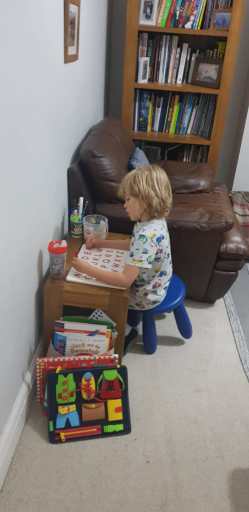I sat on the cold, hard floor, my phone in my hand displaying a picture of a writing book followed by a piece of chocolate.
“Rhys, First writing then chocolate” I stated, pointing to each picture in turn. It was the tenth time I had muttered the phrase but each time I had remained calm and consistent, while Rhys remained stubborn and resilient.
There was a goal in mind, and it was even more important for me to push forward in progress due to school closures across the country. Covid had taken its hold and we had been confined to our house for the past three months, with no sight of change or the reintroduction of education. In the absence of formal schooling I needed to step up. I needed to develop and teach my son.
“Rhys. First writing then chocolate” I said once again, knowing that the reward needed to be big to get my son to even consider doing something out of the norm. The same response was returned, a scream of frustration and refusal to follow through in my request.
I looked towards the bright digital display on the oven, I had been persevering for over twenty minutes, with not one of us willing to cave into defeat. I hadn’t introduced anything fundamentally new in months.Coping with everyday life had been the priority, but now things were going to change, we were going to push through. The first step was always the hardest, the introduction of a new routine or developmental need. I knew that this was the worst bit, it would get easier. I just needed to stay calm and strong.
I stood up and opened the cupboard, taking out a mini bar of Kinder chocolate, realising that the image of the chocolate wasn’t enticing enough. Sitting back down on the hard surface, I placed the book and pencil in front of me, and in Rhys’ line of sight. I then repeated my request, but with an addition to what we had last time. “Rhys, writing” I said pointing to the picture on my phone and then pushing the book forward in his direction, then I said the words “then chocolate” pointing to the picture on my phone, then holding the physical chocolate in front of me. Rhys saw his reward immediately, and lunged for it, but I was quick.
“Rhys writing then chocolate” I said again, pushing the chocolate out of his reach and placing the pen in his open grasp. I then guided his hand to the page, and he traced over the letter ‘L’ with physical frustration and the anger from losing the standoff. Immediately I gave him the mini kinder chocolate. “Well done, writing finished, now chocolate”.
Rhys consumed the chocolate in one bite.
It had taken forty minutes to get Rhys to trace a single letter in the book.

Two hours later I was seated once again on the hard kitchen floor, my phone in my hand and the book in front of me. “Rhys, writing then chocolate” I stated, pointing to each picture in turn. With the memory and taste of the chocolate still in his month, Rhys took the pen and drew another ‘L’, then looked at me, “Chocolate” he said, and I handed him his reward.
Although a teacher or health visitor may not advocate the use of chocolate as a reward, that is where I have the advantage. I can bend these societal views and offer my son whatever reward will get us over that first hurdle. After those first few challenging days, I started to change rewards, to bubbles, or an icelolly. The length of time Rhys started to write extended over time through perseverance and consistency.
That was five months ago.
I stood up this morning to get a cup of tea, and walking past the lounge I caught sight of Rhys sitting at his little table, pen in hand doing his writing. It had not been prompted by myself, a task he had gone and done himself. Those forty minutes, five months ago that I sat on the same kitchen floor, were worth every second to see Rhys this morning.
A change takes time. The implementation of a strategy takes time. Often it is painful and tough and moments of wanting to scream. But I hold that all inside, remain calm and persevere. Seeing my son independently taking himself to do writing, is proof that it is all worth it.
Get your pictures out and try the First-Then strategy.







